Production of Low Cost Carbon-Fiber through Energy Optimization of Stabilization Process
Abstract
:1. Introduction
- Develop a model for physical property of the OPF (here density) in the second zone of stabilization process, which can then be considered in the optimization of energy consumption in the process.
- Develop a surrogate model for energy consumption and management.
- Optimize the energy consumption in the stabilization process, given the range of process constraints, such as fiber density.
2. Materials and Methods
3. Modeling Framework
3.1. Support Vector Regression (SVR)
3.2. Artificial Neural Network (ANN)
3.3. Performance Validation
3.4. Energy Sources and Model Structure
4. Results
4.1. Predictive Model Validation
4.2. Optimization of Energy Consumption
5. Conclusions
Acknowledgments
Author Contributions
Conflicts of Interest
References
- Khayyam, H. Stochastic models of road geometry and wind condition for vehicle energy management and control. IEEE Trans. Veh. Technol. 2012, 62, 61–68. [Google Scholar] [CrossRef]
- Khayyam, H.; Naebe, M.; Bab-Hadiashar, A.; Jamshidi, F.; Li, Q.; Atkiss, S.; Buckmaster, D.; Fox, B. Stochastic optimization models for energy management in carbonization process of carbon fiber production. Appl. Energy 2015, 158, 643–655. [Google Scholar] [CrossRef]
- Khayyam, H.; Naebe, M.; Zabihi, O.; Zamani, R.; Atkiss, S.; Fox, B. Dynamic Prediction Models and Optimization of Polyacrylonitrile (PAN) Stabilization Processes for Production of Carbon Fiber. IEEE Trans. Ind. Inform. 2015, 11, 887–896. [Google Scholar] [CrossRef]
- Gupta, A.K.; Guntuku, S.C.; Desu, R.K.; Balu, A. Optimisation of turning parameters by integrating genetic algorithm with support vector regression and artificial neural networks. Int. J. Adv. Manuf. Technol. 2014, 77, 331–339. [Google Scholar] [CrossRef]
- Chen, S.-M.; Lee, S.-H.; Lee, C.-H. A new method for generating fuzzy rules from numerical data for handling classification problems. Appl. Artif. Intell. 2001, 15, 645–664. [Google Scholar] [CrossRef]
- Horng, Y.-J.; Chen, S.-M.; Chang, Y.-C.; Lee, C.-H. A new method for fuzzy information retrieval based on fuzzy hierarchical clustering and fuzzy inference techniques. IEEE Trans. Fuzzy Syst. 2005, 13, 216–228. [Google Scholar] [CrossRef]
- Chen, S.-M. A fuzzy reasoning approach for rule-based systems based on fuzzy logics. IEEE Trans. Syst. Man Cybern. Part B (Cybern.) 1996, 26, 769–778. [Google Scholar] [CrossRef] [PubMed]
- Vapnik, V.N.; Vapnik, V. Statistical Learning Theory; Wiley: New York, NY, USA, 1998. [Google Scholar]
- Kulkarni, S.; Harman, G. An Elementary Introduction to Statistical Learning Theory; Wiley Series in Probability and Statistics; Wiley: Hoboken, NJ, USA, 2011. [Google Scholar]
- Lu, Z.J.; Xiang, Q.; Wu, Y.M.; Gu, J. Application of support vector machine and genetic algorithm optimization for quality prediction within complex industrial process. In Proceedings of the 2015 IEEE 13th International Conference on Industrial Informatics (INDIN), Cambridge, UK, 22–24 July 2015; pp. 98–103. [Google Scholar]
- Huang, C.; Moraga, C. A diffusion-neural-network for learning from small samples. Int. J. Approx. Reason. 2004, 35, 137–161. [Google Scholar] [CrossRef]
- Pal, M.; Foody, G.M. Evaluation of SVM, RVM and SMLR for accurate image classification with limited ground data. IEEE J. Sel. Top. Appl. Earth Observ. Remote Sens. 2012, 5, 1344–1355. [Google Scholar] [CrossRef]
- Badii, K.; Church, J.S.; Golkarnarenji, G.; Naebe, M.; Khayyam, H. Chemical structure based prediction of PAN and oxidized PAN fiber density through a non-linear mathematical model. Polym. Degrad. Stab. 2016, 131, 53–61. [Google Scholar] [CrossRef]
- Khayyam, H.; Fakhrhoseini, S.M.; Church, J.S.; Milani, A.S.; Bab-Hadiashar, A.; Jazar, R.N.; Naebe, M. Predictive modelling and optimization of carbon fiber mechanical properties through high temperature furnace. Appl. Therm. Eng. 2017, 125 (Suppl. C), 1539–1554. [Google Scholar] [CrossRef]
- Golkarnarenji, G.; Naebe, M.; Church, J.S.; Badii, K.; Bab-Hadiashar, A.; Atkiss, S.; Khayyam, H. Development of a predictive model for study of skin-core phenomenon in stabilization process of PAN precursor. J. Ind. Eng. Chem. 2017, 49, 46–60. [Google Scholar] [CrossRef]
- Khayyam, H.; Golkarnarenji, G.; Jazar, R.N. Limited Data Modelling Approaches for Engineering Applications. In Nonlinear Approaches in Engineering Applications; Jazar, R.N., Ed.; International Publication Springer: Cham, Switzerland, 2017. [Google Scholar]
- Golkarnarenji, G.; Naebe, M.; Badii, K.; Milani, A.S.; Jazar, R.N.; Khayyam, H. Support vector regression modelling and optimization of energy consumption in carbon fiber production line. Comput. Chem. Eng. 2018, 109, 276–288. [Google Scholar] [CrossRef]
- Zhang, Y.; Zhang, X.; Tang, L. Energy Consumption Prediction in Ironmaking Process Using Hybrid Algorithm of SVM and PSO. In Proceedings of the Advances in Neural Networks—ISNN 2012: 9th International Symposium on Neural Networks, Shenyang, China, 11–14 July 2012; Wang, J., Yen, G.G., Polycarpou, M.M., Eds.; Part II. Springer: Berlin/Heidelberg, Germany, 2012; pp. 594–600. [Google Scholar]
- Curilem, M.; Acuña, G.; Cubillos, F.; Vyhmeister, E. Neural networks and support vector machine models applied to energy consumption optimization in semiautogeneous grinding. Chem. Eng. Trans. 2011, 25, 761–766. [Google Scholar]
- Kant, G.; Sangwan, K.S. Predictive modelling for energy consumption in machining using artificial neural network. Procedia CIRP 2015, 37, 205–210. [Google Scholar] [CrossRef]
- Chen, S.-M.; Chien, C.-Y. Parallelized genetic ant colony systems for solving the traveling salesman problem. Expert Syst. Appl. 2011, 38, 3873–3883. [Google Scholar] [CrossRef]
- Tsai, P.-W.; Pan, J.-S.; Chen, S.-M.; Liao, B.-Y.; Hao, S.-P. Parallel cat swarm optimization. In Proceedings of the 2008 International Conference on Machine Learning and Cybernetics, Kunming, China, 12–15 July 2008; Volume 6, pp. 3328–3333. [Google Scholar]
- Tsai, P.-W.; Pan, J.-S.; Chen, S.-M.; Liao, B.-Y. Enhanced parallel cat swarm optimization based on the Taguchi method. Expert Syst. Appl. 2012, 39, 6309–6319. [Google Scholar] [CrossRef]
- Chen, S.-M.; Kao, P.-Y. TAIEX forecasting based on fuzzy time series, particle swarm optimization techniques and support vector machines. Inf. Sci. 2013, 247, 62–71. [Google Scholar] [CrossRef]
- Chen, S.-M.; Chung, N.-Y. Forecasting enrollments of students by using fuzzy time series and genetic algorithms. Int. J. Inf. Manag. Sci. 2006, 17, 1–17. [Google Scholar]
- Golkarnarenji, G. Predictive Modelling and Multi-Objective Optimisation in Thermal Stabilisation Process of Carbon Fibre. Ph.D. Thesis, IFM, Geelong, Australia, 2017. [Google Scholar]
- Gunn, S.R. Support vector machines for classification and regression. ISIS Tech. Rep. 1998, 14, 5–16. [Google Scholar]
- Vapnik, V.; Golowich, S.E.; Smola, A. Support Vector Method for Function Approximation, Regression Estimation, and Signal Processing. Available online: https://pdfs.semanticscholar.org/43ff/a2c1a06a76e58a333f2e7d0bd498b24365ca.pdf (accessed on 27 February 2018).
- Keerthi, S.S.; Lin, C.-J. Asymptotic behaviors of support vector machines with Gaussian kernel. Neural Comput. 2003, 15, 1667–1689. [Google Scholar] [CrossRef] [PubMed]
- Fu, L.; Li, P. The research survey of system identification method. In Proceedings of the 2013 5th International Conference on Intelligent Human-Machine Systems and Cybernetics (IHMSC), Hangzhou, China, 26–27 August 2013; Volume 2, pp. 397–401. [Google Scholar]
- Davim, P. Computational Methods for Optimizing Manufacturing Technology Models and Techniques; IGI Global: Hershey, PA, USA, 2012. [Google Scholar]
- Kermani, B.G.; Schiffman, S.S.; Nagle, H.T. Performance of the Levenberg–Marquardt neural network training method in electronic nose applications. Sens. Actuators B Chem. 2005, 110, 13–22. [Google Scholar] [CrossRef]
- Cherkassky, V.; Mulier, F.M. Learning from Data: Concepts, Theory, and Methods; John Wiley & Sons: Hoboken, NJ, USA, 2007. [Google Scholar]
- Hagan, M.T.; Menhaj, M.B. Training feedforward networks with the Marquardt algorithm. IEEE Trans. Neural Netw. 1994, 5, 989–993. [Google Scholar] [CrossRef] [PubMed]
- Cortes, C.; Vapnik, V. Support-vector networks. Mach. Learn. 1995, 20, 273–297. [Google Scholar] [CrossRef]
- Hu, W.; Yan, L.; Liu, K.; Wang, H. A short-term traffic flow forecasting method based on the hybrid PSO-SVR. Neural Process. Lett. 2016, 43, 155–172. [Google Scholar] [CrossRef]
- Badii, K.; Naebe, M.; Golkarnarenji, G.; Dhami, N.; Atkiss, S.; Buckmaster, D.; Fox, B.L.; Khayyam, H. Energy Saving in Electric Heater of Carbon Fiber Stabilization Oven. In Proceedings of the 4th International Conference on Artificial Intelligence with Applications in Engineering and Technology (ICAIET), Kota Kinabalu, Malaysia, 3–5 December 2014; pp. 109–114. [Google Scholar]
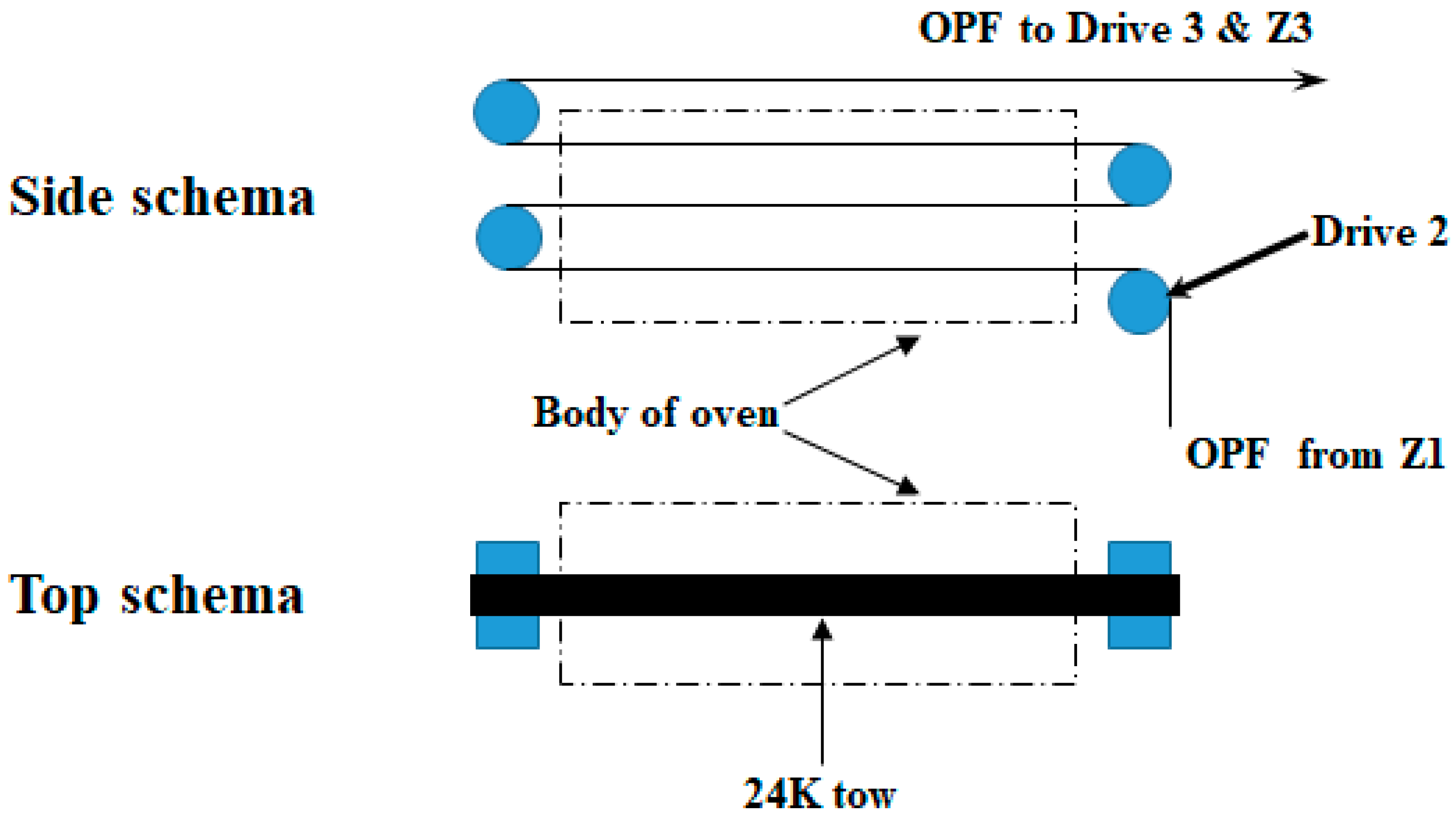
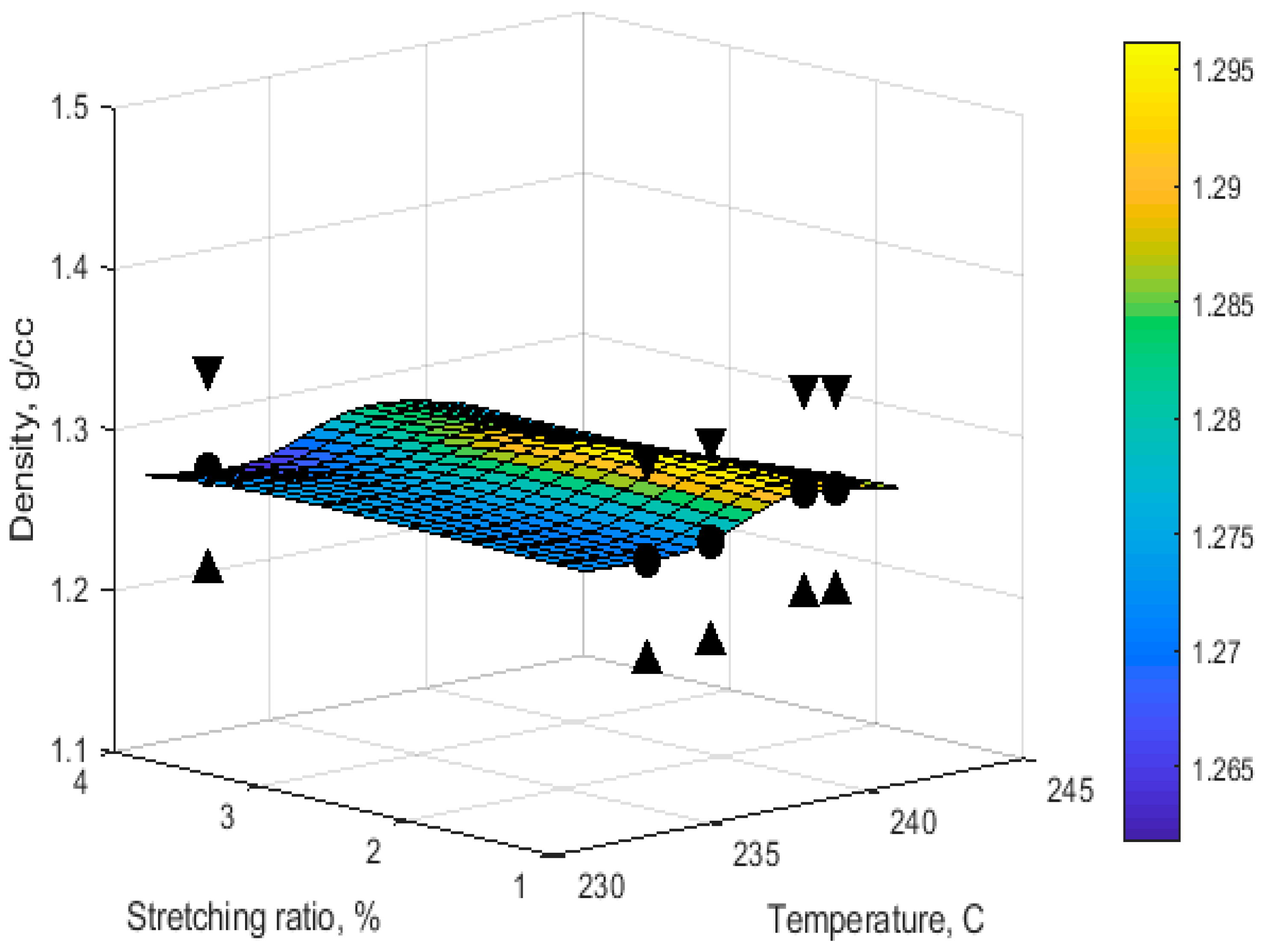
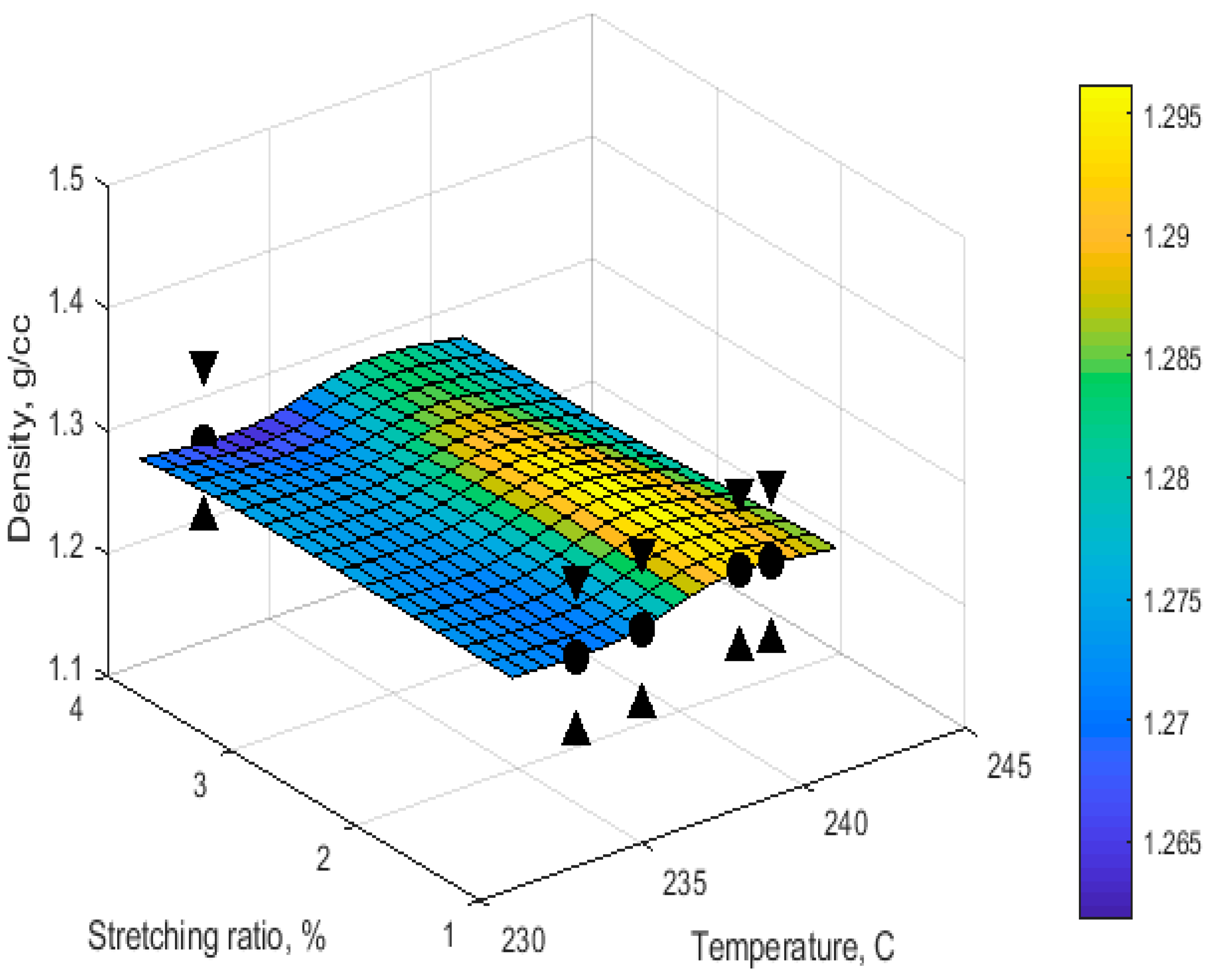
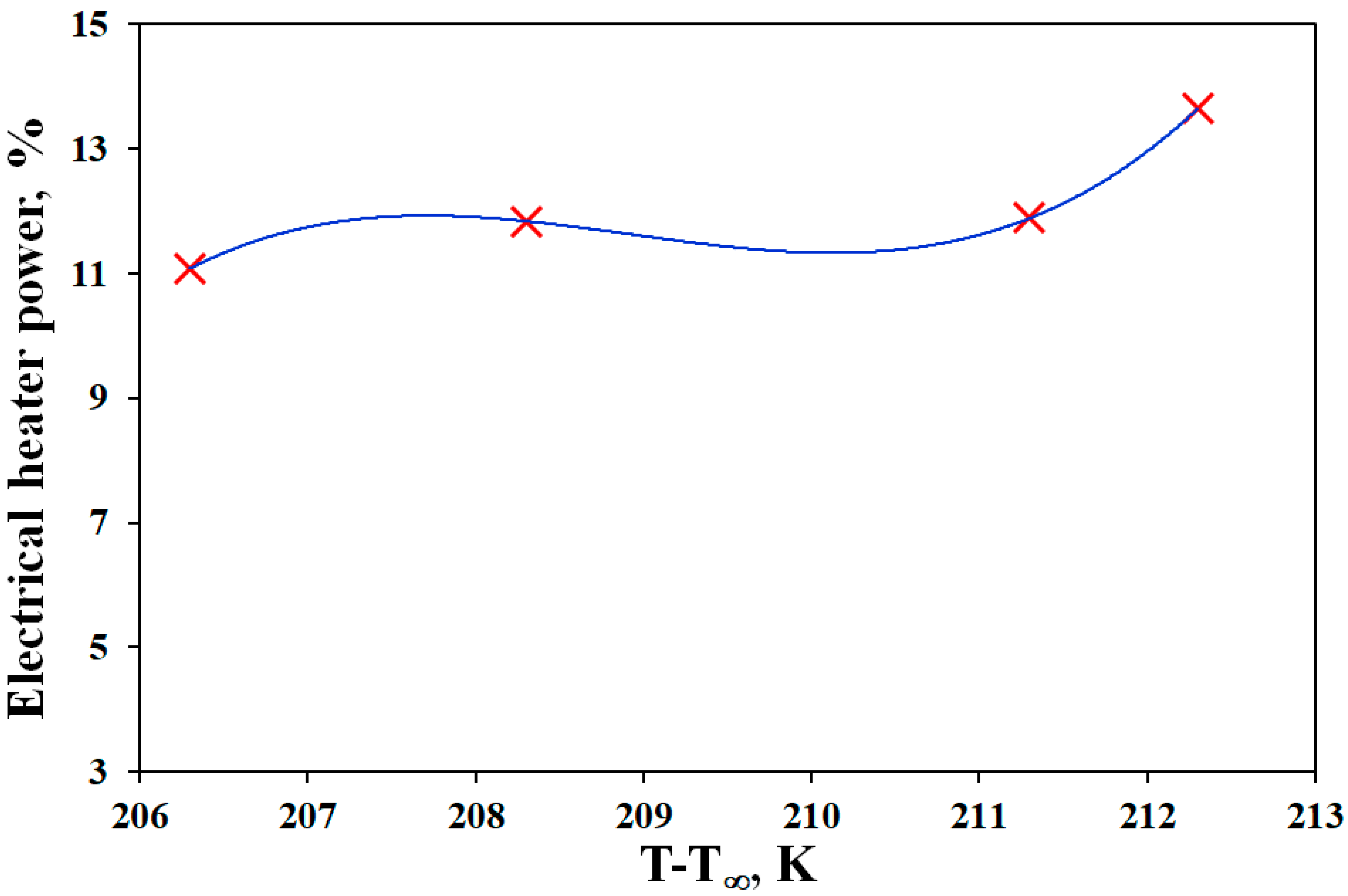
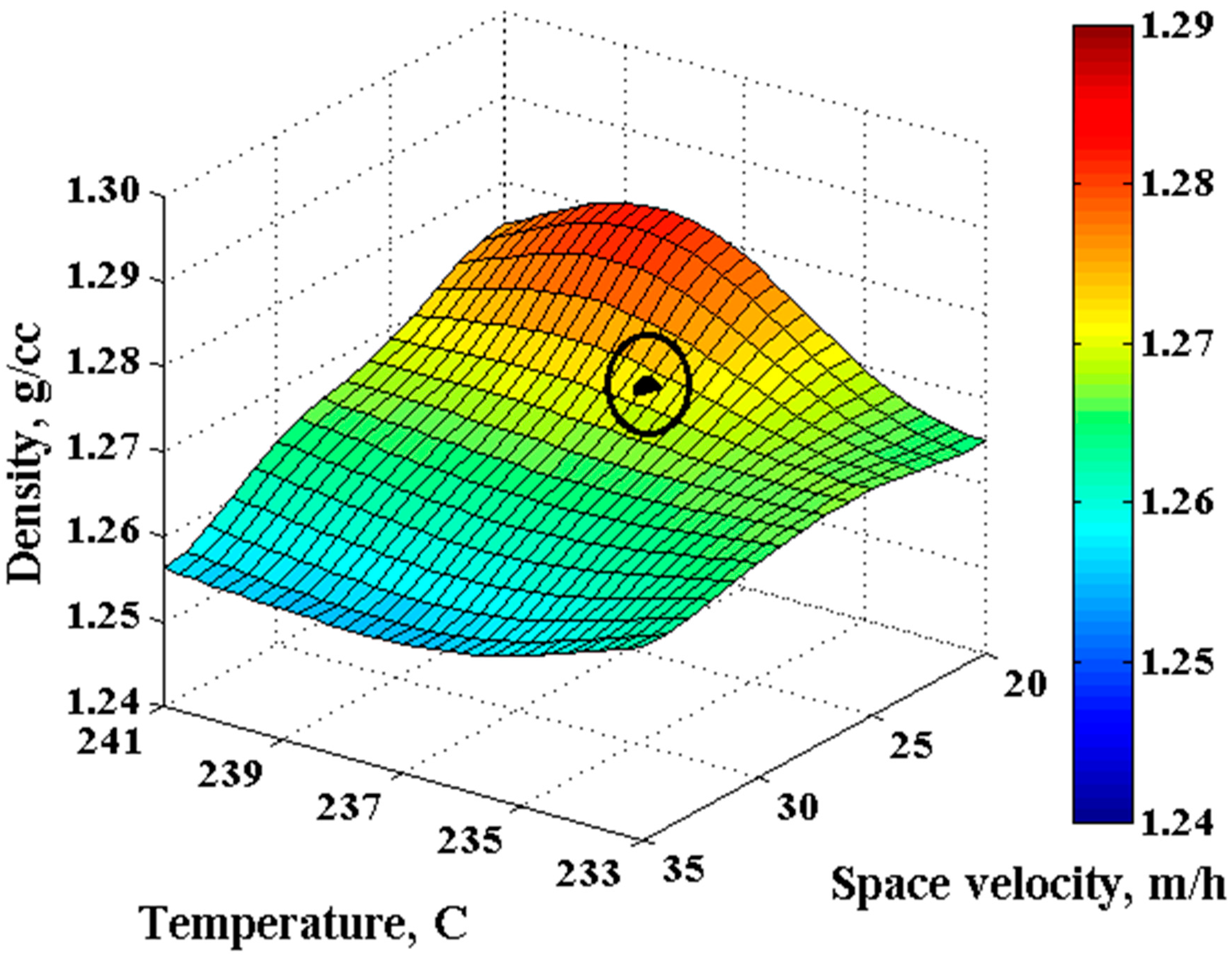
| Neural-Network Parameters | Levenberg-Marquardt |
|---|---|
| Number of input parameters | 3 |
| Number of hidden neurons | 9 |
| Number of output parameters | 1 |
| Hidden transfer function | Sigmoidal |
| Output transfer function | linear |
| Maximum number of epochs | 1000 |
| Learning rate | 0.01 |
| Momentum rate | 0.9 |
| Stopping gradient | 5.5292 × 10−8 |
| MU (momentum ) | 1 × 10−8 |
| Level | C | γ | ε |
|---|---|---|---|
| SVR-GA | 3.5739 | 3.1498 | 0.0014 |
| Extra Test Point # | 1 | 2 | 3 | SEP | CV | |
| Temperature, °C | 235 | 233 | 233 | |||
| Stretching Ration, % | 25 | 25 | 30 | |||
| Space Velocity, m/h | 2 | 4 | 2 | |||
| ρactual, g·cm−3 | 1.2580 | 1.2577 | 1.2621 | |||
| ANN-LMA | ρpredicted | 1.2761 | 1.2745 | 1.2756 | 0.0000149 | 0.0037 |
| Error, % | 1.4347 | 1.3336 | 1.0688 | |||
| SVR-GA | ρpredicted | 1.2683 | 1.2666 | 1.2654 | 0.0000117 | 0.0019 |
| Error, % | 0.8179 | 0.7073 | 0.2548 | |||
| Trial # | Temperature, °C | Fiber Space Velocity, m/h | Stretching Ratio, % | Energy Consume, MJ |
|---|---|---|---|---|
| 1 | 238 | 20 | 1 | 6.943 |
| 2 | 238 | 20 | 1 | 6.943 |
| 3 | 235 | 20 | 1 | 6.925 |
| 4 | 241 | 35 | 4 | 6.129 |
| 5 | 233 | 20 | 1 | 6.663 |
| 6 | 233 | 20 | 4 | 6.663 |
| 7 | 239 | 20 | 1 | 7.551 |
| 8 | 239 | 20 | 1 | 7.551 |
| 9 | 233 | 20 | 1 | 6.663 |
| 10 | 237 | 30 | 3 | 4.502 |
| 11 | 237 | 30 | 3 | 4.502 |
| 12 | 237 | 35 | 4 | 3.859 |
| 13 | 239 | 35 | 4 | 4.315 |
| Density Constraint, g/cm3 | T, °C | S, m/h | σ, % | Predicted Density, g/cm3 | Actual Density, g/cm3 | Optimized Energy Consumption, MJ | Maximum Eenergy Consumption, MJ | Density Error, % | Energy Saving, % |
|---|---|---|---|---|---|---|---|---|---|
| 1.27 ≤ ρ ≤ 1.29 | 236.9 | 24.5 | 4 | 1.27 | 1.29 | 5.513 | 10.726 | −1.7 | −48.6 |
© 2018 by the authors. Licensee MDPI, Basel, Switzerland. This article is an open access article distributed under the terms and conditions of the Creative Commons Attribution (CC BY) license (http://creativecommons.org/licenses/by/4.0/).
Share and Cite
Golkarnarenji, G.; Naebe, M.; Badii, K.; Milani, A.S.; Jazar, R.N.; Khayyam, H. Production of Low Cost Carbon-Fiber through Energy Optimization of Stabilization Process. Materials 2018, 11, 385. https://doi.org/10.3390/ma11030385
Golkarnarenji G, Naebe M, Badii K, Milani AS, Jazar RN, Khayyam H. Production of Low Cost Carbon-Fiber through Energy Optimization of Stabilization Process. Materials. 2018; 11(3):385. https://doi.org/10.3390/ma11030385
Chicago/Turabian StyleGolkarnarenji, Gelayol, Minoo Naebe, Khashayar Badii, Abbas S. Milani, Reza N. Jazar, and Hamid Khayyam. 2018. "Production of Low Cost Carbon-Fiber through Energy Optimization of Stabilization Process" Materials 11, no. 3: 385. https://doi.org/10.3390/ma11030385




